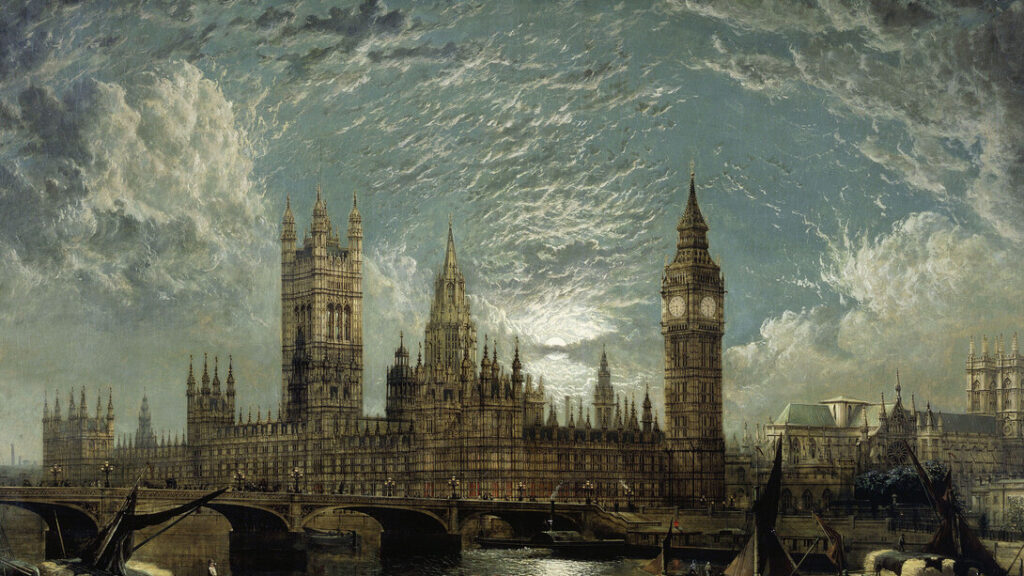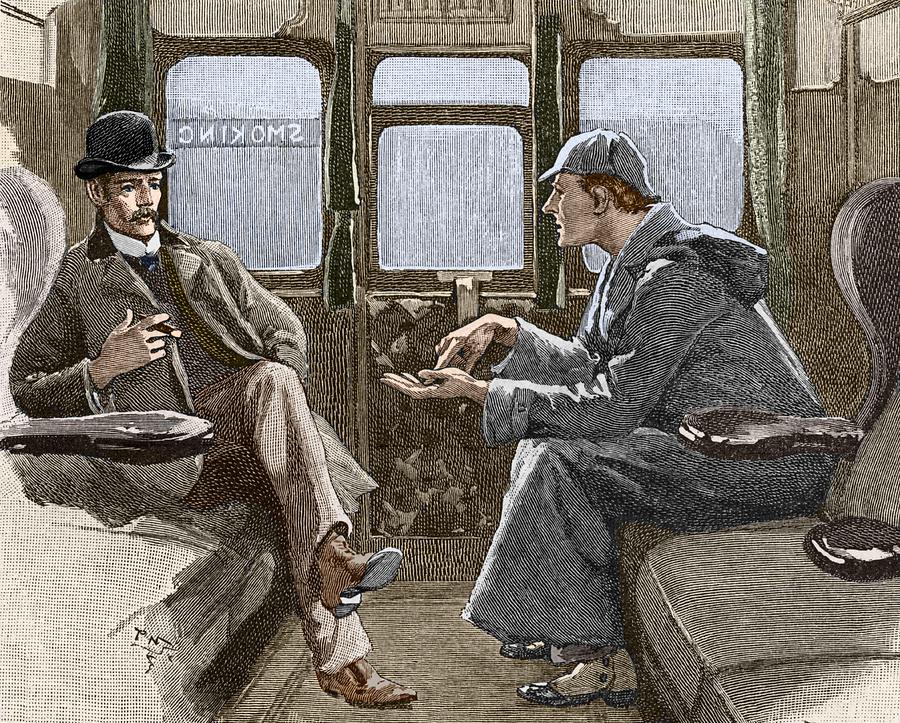Picture the following silhouette in your mind featuring the deerstalker hat, a prominent nose, a magnifying glass, and a pipe. Sherlock Holmes, created by Sir Arthur Conan Doyle, is the most well-known character in all of English criminal fiction. Holmes’s impact on the criminal fiction genre is so great that his character has served as the foundation of several fictional detectives that were created after him. For example, modern TV detectives like Dr House are also based on Holmes’ character. Though it has been more than a century since Sir Arthur Conan Doyle created him, Sherlock Holmes remains as popular as he did in the late Victorian Era in England.
The world in which these stories take place is a mixture of the popular culture perception (such as in the Robert Downey Jr. Sherlock Holmes movies or TV show Ripper Street) and the reality of industrial London. For instance, when many of us first think of Victorian London, we picture a foggy, poorly lit city at night with Jack the Ripper stalking women with a knife in hand and slaughtering them. But this image is far from the whole truth! The London that Sir Arthur Conan Doyle lived in features some extravagant buildings, shopping areas, well-lit streets and much more. It was also making progress in the sectors of communication and travel, including large railway terminals, a country-wide telegraph system and a flourishing press. London, however, was a city of huge contrasts between the rich and the poor. Its modernity and soci0-economic divisions have been highlighted, or at least mentioned as a backdrop, in the writings of contemporaries like Henry James, Charles Booth, Beatrice Potter Webb and even H.G. Wells.
From the bustling streets of London to the quiet countryside, Sir Arthur Conan Doyle’s iconic detective takes the readers on a journey through a world that is both familiar and strange. But how accurate is the depiction of Victorian England in the Sherlock Holmes stories? Were the class divisions, social customs, and technological innovations of the time accurately portrayed, or were they distorted by the author’s biases and assumptions? In this article, we will explore the depiction of Victorian England in the Sherlock Holmes stories and examine how well it reflects the reality of the time.
Representation of the Social Classes: The New Middle Class
Victorian society was highly stratified, with a clear distinction between the wealthy upper class and the working class. This is evident in the Sherlock Holmes stories, where we see both sides of the spectrum as well as the middle class.
The wealthy and elite of society are often (but not always) portrayed as arrogant, self-centered, and out of touch with the realities of life. On the other hand, the working class is frequently depicted as hardworking, honest, and down-to-earth. For example, in A Scandal in Bohemia, the King of Bohemia is portrayed as arrogant and entitled, while his mistress, Irene Adler, is shown to be more intelligent and resourceful than him.
The Victorian era saw the emergence of a new middle class in England, driven by factors such as industrialization, urbanization, and improvements in education and social mobility. This middle class, made up of professionals, managers, and entrepreneurs, had distinct values and characteristics, such as a belief in hard work, education, social mobility, and a strong sense of morality and respectability. This is seen in The Adventure of the Speckled Band, where Helen Stoner is a middle-class woman who is struggling to make ends meet after the death of her mother and sister. Despite her difficult circumstances, she is portrayed as courageous and determined.
Lastly, the working classes are portrayed as honest, hardworking, and vulnerable to the exploitation and abuse of the upper classes. For example, in The Adventure of the Blue Carbuncle, a poor man named John Horner is wrongly accused of stealing a valuable gemstone. Despite being innocent, he is depicted as powerless to defend himself against the accusations of his employers and, more importantly, the police, as he has a criminal record.

In terms of the settings of the story and the volume of characters featured, Conan Doyle moved away from the poorer parts of London as he was writing primarily for a bourgeois audience. Following the novel, The Sign of Four, in particular, the stories moved to more affluent neighborhoods of London or prosperous countryside settings. This major change in setting is also mirrored in the class of the characters featured, as both the victims and the villains were often more wealthy than not. Lord Bellinger from The Adventure of the Second Stain is a good example of the same. As for the villain prototype, there is no better example than that of Professor James Moriarty, Holmes’s nemesis, albeit not in the original stories but in tales since then. Moriarty, in The Final Problem, is described as the “Napoleon of Crime” and “an aristocrat of crime” as well.
While the middle and upper classes are the focus of Conan Doyle’s stories owing to his primary readership, it is not as though the lower/working classes are underrepresented. Far from it, in fact, Holmes outright says he doesn’t care about his client’s position, or lack thereof, in society. He states, “The status of my client is a matter of less moment to me than the interest of his case”, and it is with this mindset that he approaches cases and clients both. Governess Violet Smith in The Adventure of the Solitary Cyclist is one such example.
Holmes could also skillfully weave in and out of different classes seamlessly, owing to his excellent disguises and acting prowess, apart from employing the famous Baker Street Irregulars, a group of street urchin boys led by Wiggins. His employment of the Baker Street Irregulars is based more upon how useful he finds them as no one will notice an urchin child in London, as opposed to a policeman or Holmes himself. However, his putting them in potential danger during his criminal investigations was a topic that proved controversial with modern fans. It was even explored in detail in The House of Silk by Anthony Horowitz, a unique book that the Arthur Conan Doyle Estate authorized.
Gender Roles and the Depiction of Women
The depiction of gender roles in the Sherlock Holmes stories reflects the societal norms and expectations of the Victorian era. Women are generally portrayed as delicate and emotional, while men are portrayed as rational and logical. Female characters in the stories are typically depicted as helpless victims or scheming villains, except for a few exceptions. One of the most notable examples of this can be seen in A Scandal in Bohemia, where Irene Adler is the only woman who is able to outsmart Sherlock Holmes.
The stories also reinforce traditional gender roles, with men occupying positions of power and authority while women are relegated to domestic roles. For instance, in The Adventure of the Speckled Band, the villainous stepfather is shown as a successful doctor, while the female protagonist is mostly confined to her bedroom and must rely on a male detective to solve the mystery.
On the whole, though, female characters rarely occupy positions of prominence in the stories; they don’t have too many dialogues or agency and almost always need a man’s help. The most notable exception to this is Irene Adler, as mentioned above, but there are others as well: Isadora Klein as a stereotypical femme fatale from The Three Gables and Miss Burnet, another stereotype, is a scorned woman hell-bent on revenge in Wisteria Lodge.
Apart from these less-than-flattering depictions of women that reduce them to stereotypes, there are other examples of women characters being written less-than-fairly even when granted more agency in the stories. Lady Trelawney Hope, for instance, is responsible for the pivotal crime in The Second Stain, and the case needs Holmes, a man, to restore the prevailing patriarchal structure. Apart from these, women in Conan Doyle’s stories are also depicted as hysterical, simple-minded, and mainly timid.
To place these stories in the historical context, this was when women were protesting against their subservience to men, challenging voting rights, among other things. None of this is mentioned in Conan Doyle’s stories at all; although he does indirectly portray the possible suffering of women by featuring an abusive marriage in The Abbey Grange.
Overall, the depiction of women’s roles in the Sherlock Holmes stories is limited and often reinforces gender stereotypes and societal norms of the time period. While there are some examples of strong female characters, they are few and far between, and ultimately, the stories reflect the patriarchal structure of Victorian society.
Transportation in London
The late Victorian era saw significant improvements in transportation in London, which had a major impact on the city’s development and the lives of its inhabitants. The expansion of railways, the introduction of the underground system, and the use of electric trams and buses transformed how people moved around the city and helped to connect different areas more effectively. The railways played a particularly important role in the late Victorian era. The construction of new lines and the expansion of existing ones made it easier for people to travel into and out of London and between different parts of the city. This allowed workers to commute to their jobs more easily and helped to fuel the growth of suburbs and satellite towns.
In the stories, characters often travel from the suburbs into the city, reflecting the growing trend of commuting. For example, in The Adventure of the Dancing Men, Holmes and Watson travel to the suburb of Norfolk to investigate a case. The stories also depict the growth of suburban communities and the development of new housing estates. In The Adventure of the Copper Beeches, for example, a governess is offered a job in a remote country house on the outskirts of London. This highlights the growing trend of middle-class families moving out of the city to escape the pollution and overcrowding.
Another mode of transportation, and probably the most iconic in Sherlock Holmes stories, in Victorian London was the hansom cab. It was a two-wheeled vehicle drawn by a single horse and was designed to be both fast and maneuverable, making it a popular choice for navigating the crowded and narrow streets of the city. The hansom cab was also relatively affordable, making it accessible to a wide range of people. The hansom cab makes an appearance in several stories, sometimes in chase scenes and at other times to track down someone who took a hansom cab during a case.
As the above paragraphs highlight, Victorian London’s rapid technological and industrial development gave birth to what is considered completely normal today: the commuting worker. Before that, workers had to live close to their workplace, but with better travel and transportation options, they could commute to and from the workplace easily. But the downside of this development also led to overcrowding and pollution, resulting in several people desiring life in the calmer, quieter suburbs or even the countryside, as noted by Watson in The Sign of Four.
Conclusion
Historically, the late Victorian Era brought massive changes for England on several fronts – rapid industrialization, an increasingly large population making London one of the most populated cities in the world, urbanization, and technological growth. In many ways, the values of the times had yet to catch up with these advancements, and that led to a wide gap between the two.
Having said that, Sir Arthur Conan Doyle himself was often contradictory to himself, being liberal in some ways and conforming to the conservative social values and beliefs of the time in others. On the whole, the Sherlock Holmes stories paint a complex socio-cultural portrait of Victorian England as a rapidly evolving English society.

